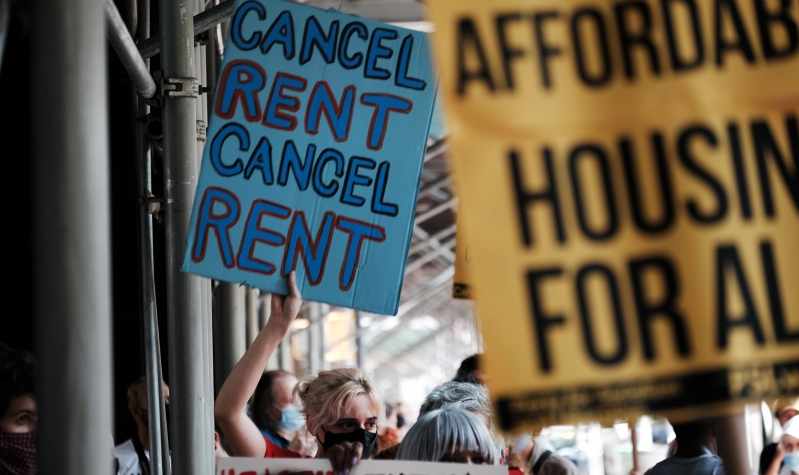
More financial assistance and fewer anti-eviction mandates may better shelter both renters and landlords.
Many have criticized the U.S. Supreme Court’s recent decision to block the federal eviction moratorium instituted by the U.S. Centers for Disease Control and Prevention (CDC), asserting that this ruling would engender increased housing insecurity among millions of low-income renters during the ongoing coronavirus pandemic.
Yet this decision and its consequences were inevitable, due to months of overdependence on eviction moratoriums as long-term solutions predicated upon changing the market-based relationship between landlords and renters.
Since the onset of the pandemic, policymakers on both sides of the political spectrum have generally supported eviction moratoriums despite their questionable efficacy and legality—as a way to mitigate the economic devastation of a historic, global pandemic on low-income renters.
Landlords throughout the United States observed a near-continuous federal moratorium on evictions, first enacted via legislation through the Coronavirus Aid, Relief, and Economic Security (CARES) Act from March through June of 2020. That moratorium was later continued to December 2020 via public health orders from the CDC, and subsequently to January, March, June, and October of 2021.
Sadly, eviction moratoriums were never independently sustainable solutions.
The CDC’s focus on prohibiting evictions by landlords on behalf of renters neglected the reality that landlords, like their tenants, are also debtors with mortgages, insurance, and taxes, yet they were expected to maintain normal services while operating at a loss during an eviction moratorium.
Almost 90 percent of U.S. landlords are individual investors, or “mom-and-pop” landlords, that retain an average household income of $97,000 per year, with rental revenues comprising 5 to 20 percent of their annual earnings. Mom-and-pop landlords are more likely to cater to low-income tenants, charge lower rents, face increased operating costs, and maintain a smaller financial cushion than corporate landlords from which to absorb any lapses in rental payments.
For each of the 10.9 million renters estimated to be at risk of falling behind on their rent at the onset of the coronavirus pandemic, approximately one mom-and-pop landlord saw a reduction in income following subsequent eviction moratoriums. Eviction moratoriums simply shifted the threat of economic hardship from renters to landlords, to the benefit and detriment of just as many people.
In fact, the spillover effects from eviction moratoriums on local housing markets and economies, due to the ensuing financial instability for landlords, are the very same crises these policies were intended to prevent by reducing financial instability for renters. This unfortunate result was a natural outcome as eviction moratoriums inherently disregard the conditional dependence of both landlords and the broader economy on income from renters.
So, suspending evictions––a key guarantor to renters’ fulfillment of their financial obligations––was never a long-term solution, absent ample resources to mitigate moratoriums’ successive shockwaves on landlords, the housing market, and economy at large.
Yet despite these inherent deficiencies, short-term eviction moratoriums could have bought renters and landlords valuable time to develop financial buffers against long-term housing insecurities, aggravated by the coronavirus pandemic. Unfortunately, policymakers did not clearly define and maintain their timelines, nor did they effectively disburse additional aid to landlords and renters in preparation for an eventual expiration of these policies.
Both the federal eviction moratorium and the many other moratoriums instituted at the state level were arbitrarily extended for months on end without clear timelines or specific criteria for repeal. These extensions created undue economic uncertainty for landlords and local housing markets while diminishing the credibility of moratoriums as a solution.
Furthermore, landlords had few direct options to recover lost income while such eviction moratoriums were active. Most were ineligible to receive relief from the now-expired Paycheck Protection Program and were further prohibited from using Pandemic Unemployment Assistance, as made available by the CARES Act, to substitute unpaid rental income.
Conversely, landlords were eligible to receive Economic Injury Disaster Loans, but actual relief was capped to a $10,000 emergency grant per applicant. Although landlords and their tenants were also eligible for financial assistance via the Emergency Rental Assistance Program (ERAP), a mere $5.1 billion out of $46.5 billion in allocated funds has been disbursed to applicants since its ratification through the CARES Act last year.
In light of the Supreme Court’s decision against eviction moratoriums enacted in response to executive orders—and with the expiration of most state-level mandates in August—policymakers may be tempted to reimpose such mandates through legislative consensus, as suggested within the Court’s majority’s opinion.
Given that the majority of Americans are fully vaccinated and increased public and private mandates will likely bolster current numbers, in addition to the appreciating economic conditions and moratoriums’ intrinsic side-effects, anti-eviction mandates from the U.S. Congress likely would not muster the same level of broad support today as they would have one year ago.
Instead, removing bottlenecks in the distribution of ERAP funds to landlords and renters would be a more effective, equitable, and palatable approach for policymakers. Studies indicate that high documentation burdens, lengthy payment timelines, and insufficient infrastructure for rental support have left these funds stuck with state and local authorities. Only 11 percent of allocated funds have reached landlords and renters, while $1 for every $6 from the 2020 Coronavirus Relief Fund earmarked for rental assistance programs was redirected or unspent.
Even the Biden Administration has acknowledged that its most recent extension of the federal eviction moratorium was intended mainly to buy additional time, by providing financial assistance to landlords and renters before an eventual return to normal conditions.
With time still of the essence, policymakers must remain focused on this specific mission by streamlining the application process so that landlords and renters receive timely assistance, and synchronizing key procedural steps to avoid major disparities between states and localities.
Many landlords and renters face dire straits today, following months of overdependence on eviction moratoriums without supplemental relief for an eventual return to normal market conditions.
Instead of delaying the inevitable with further moratoriums, policymakers should facilitate an expeditious distribution of over $40 billion in remaining ERAP funds. By ensuring that financial assistance begins with landlords and renters, policymakers can kickstart the U.S. economy from the ground up, enabling all its facets to receive the support they require to thrive in a post-coronavirus environment.




